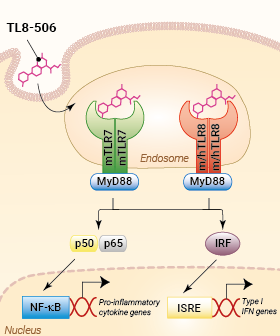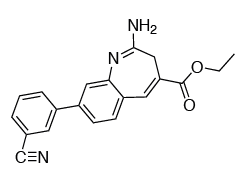TL8-506
| Product | Unit size | Cat. code | Docs. | Qty. | Price | |
|---|---|---|---|---|---|---|
|
TL8-506 Benzazepine analog - TLR8 ligand |
Show product |
500 µg |
tlrl-tl8506
|
|
TLR8 Agonist - Benzazepine analog

Activation of TLR7/8 by TL8-506
 InvivoGen also offers:
InvivoGen also offers:
• TLR reporter cells: HEK293, RAW, THP-1 cells
• TLR research tools: Antibodies, Inhibitors, etc.
TL8-506 is a benzazepine compound and an analog of the Toll-like receptor 8 (TLR8) agonist VTX-2337 [1,2]. TL8-506 is a specific agonist for human and mouse TLR8. TLR8, together with TLR7, is an endosomal pattern recognition receptor that plays an important role in the antiviral immune response [3].
Mode of action
Using our HEK-Blue™ reporter cell lines expressing human or mouse TLR7 or TLR8, we demonstrate that TL8-506 is a specific ligand for human and mouse TLR8. It does not activate human TLR7. However, due to the strong homology between murine (m) TLR7 and mTLR8, it also activates mTLR7 (see figure).
TL8-506 is more potent than the imidazoquinoline R848 (TLR7/8) and the thiazoquinolone CL075 (TLR8/7). It is ~50x and ~25x more potent in inducing NF-κB activation in TLR8-transfected HEK293 (HEK-Blue™ hTLR8) cells than R848 and CL075, respectively [data not shown].
Moreover, TL8-506 is able to activate hTLR8-dependent NF-κB and IRF pathways, as assessed using our monocytic THP1-Dual™ reporter cell lines expressing two reporter genes, for the NF-κB-inducible SEAP and IRF-inducible Lucia luciferase, as well as hTLR7 or hTLR8 (see figure). As expected, high concentrations of TL8-506 can stimulate THP1-Dual™ and THP1-Dual™ hTLR7 cells, since THP-1-derived cells endogenously express low levels of hTLR8.
Key features of TL8-506
- Strong activator of human TLR8, mouse TLR7 and mouse TLR8
- Does not activate human TLR7
- TL8-506 has been formulated to increase its solubility in water
- Each lot of TL8-506 is highly pure (≥95%) and functionally tested
References:
1. Lu H. et al., 2012. VTX-2337 is a novel TLR8 agonist that activates NK cells and augments ADCC. Clin Cancer Res. 18(2):499-509.
2. Elavazhagan S. et al., 2015. Granzyme B Expression Is Enhanced in Human Monocytes by TLR8 Agonists and Contributes to Antibody-Dependent Cellular Cytotoxicity. J Immunol. 194(6):2786-95.
3. Georg P. & Sander L.E., 2019. Innate sensors that regulate vaccine responses. Curr. Op. Immunol. 59:31.
Specifications
Specificity: TLR8 agonist
CAS number: 1268163-15-0
Solubility: 1 mg/ml in water
Formula: C20H17N3O2
Molecular weight: 331.37
Quality control:
- Purity: ≥95% (UHPLC)
- The biological activity of TL8-506 has been verified using cellular assays.
- The absence of bacterial contamination (e.g. lipoproteins and endotoxins) has been confirmed using HEK-Blue™ hTLR2 and HEK-Blue™ hTLR4 cells.
Contents
- 500 µg TL8-506
- 1.5 ml sterile endotoxin-free water
![]() TL8-506 is provided lyophilized and shipped at room temperature.
TL8-506 is provided lyophilized and shipped at room temperature.
![]() Store at -20°C.
Store at -20°C.
Details
TLR7 and TLR8
TLR7 and TLR8 are endosomal pattern recognition receptors that share structural homology [1]. Both receptors are activated by single-stranded RNA (ssRNA) molecules, however, they exhibit different ligand-binding specificities and cellular expression patterns suggesting that they have nonredundant specialized roles.
TLR7 is essentially expressed by plasmacytoid dendritic cells (pDCs) but is also found in B cells and other myeloid cells [2] while TLR8 is highly expressed by myeloid cells and is absent from pDCs and B cells [2].
The endosomal distribution of TLR7 and TLR8 allows them to scan for the presence of microbial RNA in the phagocytic cargo. Their activation leads to NF-κB-, AP1-, and interferon regulatory factor (IRF)-mediated production of type I interferons (IFN-α/β) and pro-inflammatory cytokines [2].
Structural analyses have revealed that both TLR7 and TLR8 possess two binding sites (designated as Site 1 and Site 2) which do not share the same specificities.
Site 1 is highly conserved between TLR7 and TLR8 and binds nucleosides (guanosine (G) for TLR7 and uridine (U) for TLR8) or base analogs. The ligand preference for TLR7 and TLR8 is thus explained by the presence of specific residues in Site 1. Site 1 occupancy allows receptor dimerization and signaling.
Site 2 is less conserved and binds ssRNA with U(U) and U(G) motifs, respectively [3, 4]. Of note, ssRNA-binding to Site 2 is not sufficient for the formation of a signaling-competent TLR dimer but it strongly enhances the binding affinity of Site 1 [3, 4]. Thus, TLR7 and TLR8 appear to sense distinct RNA-degradation products rather than full-length ssRNAs [4].
1. Chuang T.H. & Ulevitch R.J., 2000. Cloning and characterization of a sub-family of human toll-like receptors: hTLR7, hTLR8, and hTLR9. Eur Cytokine Netw, 11:372-8.
2. Georg P. & Sander L.E., 2019. Innate sensors that regulate vaccine responses. Curr. Op. Immunol. 59:31.
3. Zhang Z. et al., 2018. Structural analyses of Toll-like receptor 7 reveal detailed RNA sequence specificity and recognition mechanism of agonistic ligands. Cell Rep. 25:3371.
4. Tanji H. et al., 2015. Toll-like receptor 8 senses degradation products of single-stranded RNA. Nat. Struct. Mol. Biol. 22:109.
Chemical structure of TL8-506









